All the stained glass windows have been installed since St Andrew’s Church was rebuilt in 1866. Even that which had been in east window of the chancel for centuries was not re-installed.
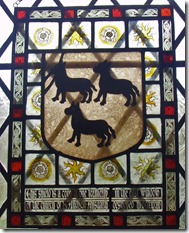 Instead that of the coats of arms of Richard, Lord Scrope of Bolton Castle and James Metcalfe of Nappa Hall was carried off to St Jude’s RC Church at Ulshaw Bridge near Middleham. The small window had been originally placed in St Andrew’s to commemorate the Battle of Agincourt in 1415 at which both Lord Scrope and James Metcalfe led men from Wensleydale. Today there are two replicas of that window at St Andrew’s. One is in the clerestory windows on the south side of the chancel and the other on the south side of the church near the Lady Chapel.
Instead that of the coats of arms of Richard, Lord Scrope of Bolton Castle and James Metcalfe of Nappa Hall was carried off to St Jude’s RC Church at Ulshaw Bridge near Middleham. The small window had been originally placed in St Andrew’s to commemorate the Battle of Agincourt in 1415 at which both Lord Scrope and James Metcalfe led men from Wensleydale. Today there are two replicas of that window at St Andrew’s. One is in the clerestory windows on the south side of the chancel and the other on the south side of the church near the Lady Chapel.
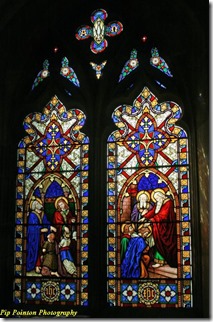
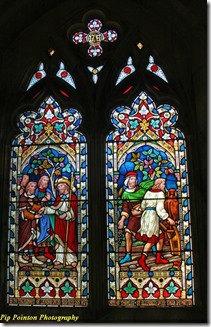 As you enter the main entrance look left to see two windows in the Baptistry. The window immediately on the left, on the south side of the church, illustrates the first confirmation (Acts 8:14-17) and the calling of Barnabas and Saul (Acts 13:2-3). (left)
As you enter the main entrance look left to see two windows in the Baptistry. The window immediately on the left, on the south side of the church, illustrates the first confirmation (Acts 8:14-17) and the calling of Barnabas and Saul (Acts 13:2-3). (left)
That behind the font, on the west side (above right), illustrates the parables of the talents and going forth to sow. This and the Rokeby window were donated by Elizabeth Dunn: that in the Baptistry was in memory of her father, Lawson Dunn and her mother.
In the Baines’s Directory of 1823 for Thoralby Lawson Dunn was listed as a portrait painter while Morris Lord Rokeby (3rd Lord Rokeby) was living at Littleburn in the same village. There was a close relationship between the Dunns and Lord Rokeby and when the latter died in 1829 he left Hill House, Thoralby, to Lawson. Lawson died a few weeks later. Lord Rokeby left substantial legacies to the Dunn family including Lawson’s daughter Elizabeth.
 To see the Rokeby Window (left) walk straight across the back of the church and look left as it is on the north west elevation. This is dedicated ‘To the memory of the right hon: Morris Lord Rokeby late of Littleburn.’ hence being known as the Rokeby Window.
To see the Rokeby Window (left) walk straight across the back of the church and look left as it is on the north west elevation. This is dedicated ‘To the memory of the right hon: Morris Lord Rokeby late of Littleburn.’ hence being known as the Rokeby Window.
The main sections depict the healing of the centurion’s servant and the parable about the workers in the vineyard.
(Information about the Dunn family and Lord Rokeby provided by Ann Hartley.)
North side of church:
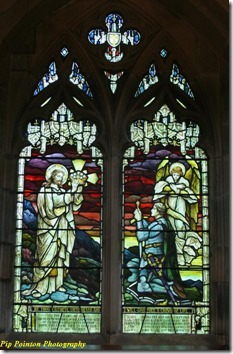
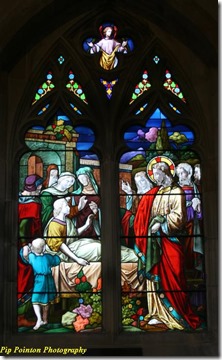 The window (left) near the War Memorial plaques is in memory of William Purchas (1841-1919) and his five sisters. The Purchas family were Lords of the Manor for several generations.
The window (left) near the War Memorial plaques is in memory of William Purchas (1841-1919) and his five sisters. The Purchas family were Lords of the Manor for several generations.
Towards the east end of the north wall is the Doctors’ Window. (right)
This illustrates the raising of the widow of Nain’s son and commemorates the life of Dr Matthew Willis who selflessly served Dales’ folk until his death in 1871.
To the left of this window are memorials to three of his successors including Dr William Pickles who was awarded a CBE in 1957 for his pioneering work on the spread of epidemic diseases which he carried out in Wensleydale.
East end of the church:
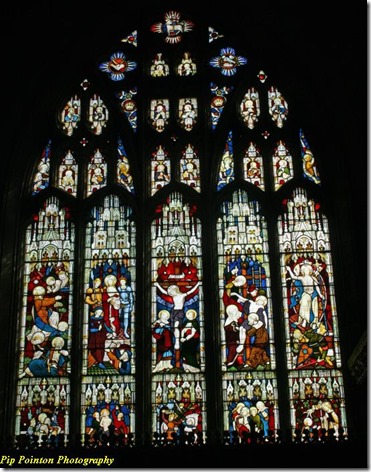 The East Window is a memorial to William and Ann Robinson of Redmire and Edgley and their children. It was unusual for the period as it was generally considered ‘high church’ (i.e. verging on Roman Catholicism as it depicts the Crucifixion).
The East Window is a memorial to William and Ann Robinson of Redmire and Edgley and their children. It was unusual for the period as it was generally considered ‘high church’ (i.e. verging on Roman Catholicism as it depicts the Crucifixion).
The main panels of the window show the Passion of Our Lord and the Ascension, the central panel being the Crucifixion. In the top part of the window are depicted the Lamb of God, the Dove (Holy Spirit) and the Pelican, drops of whose blood, as it pecks at its own chest, symbolise the Blood of Christ. Underneath are several figures obviously of the Apostles and Evangelists.
The dedication at the bottom is now hidden by the Reredos. It reads: ‘In memory of William and Anne Robinson of Redmire and Edgley and their children, Ralph Robinson and Isabella Robinson of The Cliff, Leyburn, and George Place Robinson of West Burton MDCCCLXVI.’
The window was given by Henry Thomas Robinson, son of William and Anne, also of The Cliff, Leyburn. It was installed at the rebuilding of the church in 1866.The red marble columns in the clerestory of the nave were his gifts also. Henry died in 1886 and his four daughters then gave the Reredos and altar in memory of him and his wife, Elizabeth, who died in 1868.
Vestry window:
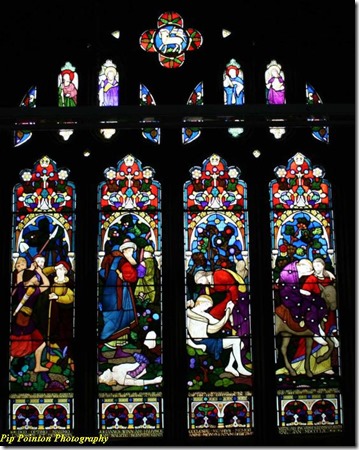 This window can only be seen when a member of the church with a key is present.
This window can only be seen when a member of the church with a key is present.
It depicts the story of the Good Samaritan and was given by the Rev John Winn (Vicar from 1827 to 1873) in gratitude for his safe deliverance from a vicious attack by robbers at his home, Nappa Mill near Askrigg, in 1860.
In the Lady Chapel
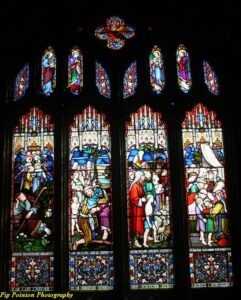 East Window: This window is in memory of George and Ann Wray, their eight sons and their sons and children who died before 1871. They include Ann Fawcett Fraser‘ The Heroine of Cawnpore’
East Window: This window is in memory of George and Ann Wray, their eight sons and their sons and children who died before 1871. They include Ann Fawcett Fraser‘ The Heroine of Cawnpore’
The four musicians shown at the top, below the eagle, are a harpist, a pipe player, a violinist and another harpist
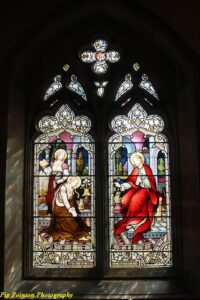
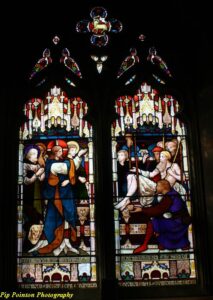 South East Window: (left) Jesus with Martha and Mary. In memory of Melesina Wray who died in Calcutta (Kolkata) in 1860 and her husband, George Octavius Wray, died in 1893.
South East Window: (left) Jesus with Martha and Mary. In memory of Melesina Wray who died in Calcutta (Kolkata) in 1860 and her husband, George Octavius Wray, died in 1893.
South West Window: (Above right) Jesus healing the sick when a man is let down on his bed through the roof (Mark 2:2-8). This window is in memory of the Rev John Chapman of Thornton Rust and Newfoundland who died in 1851.
South West near Lady Chapel:
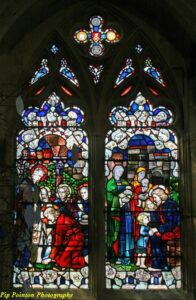 This window was designed in 1905 by Caroline Townshend – a British stained glass artist of the Arts and Crafts movement.
This window was designed in 1905 by Caroline Townshend – a British stained glass artist of the Arts and Crafts movement.
The panel on the left shows Jesus washing the feet of his disciples, and the other side depicts him blessing the children who were brought to him.
The window is in memory of Fenwick William Stow MA, vicar of Aysgarth parish 1873-1905.
Do take time to look for all the squirrels!